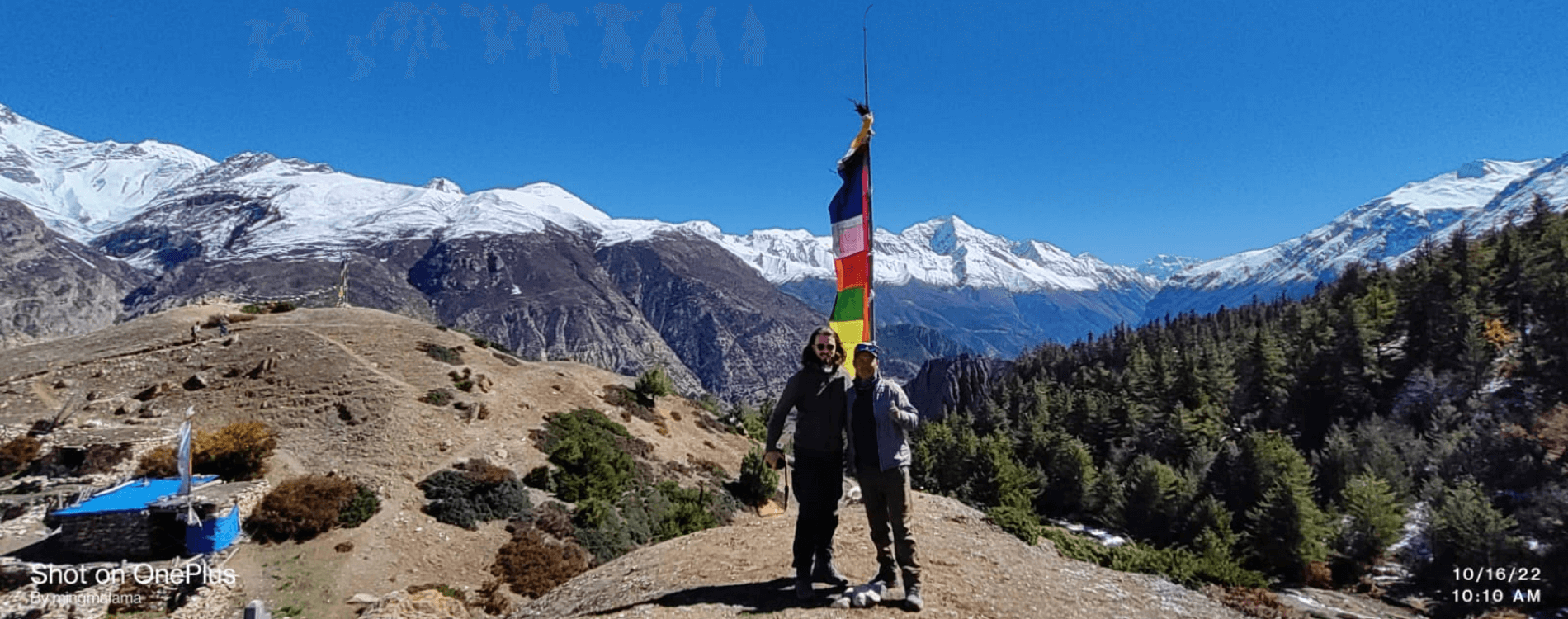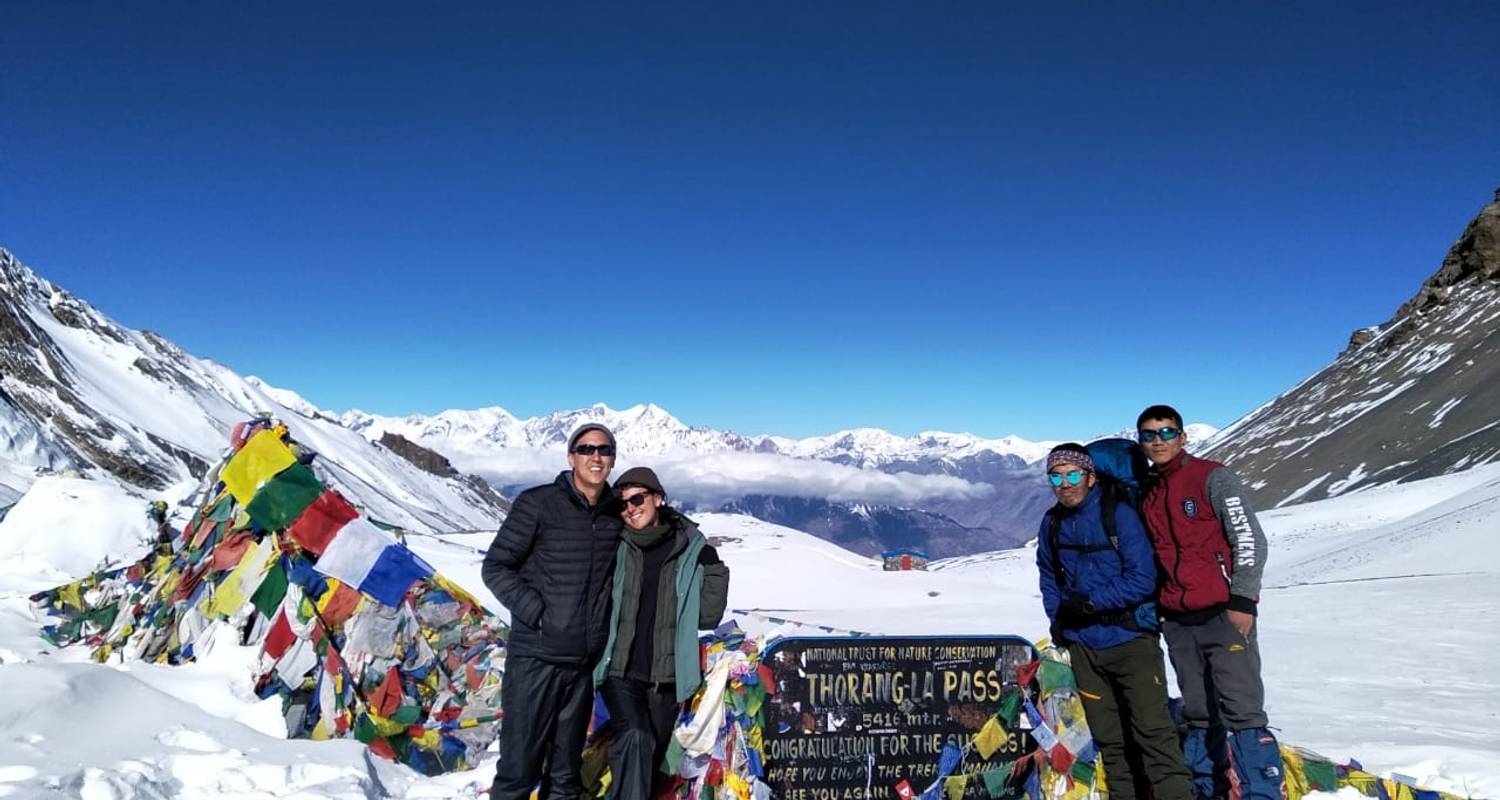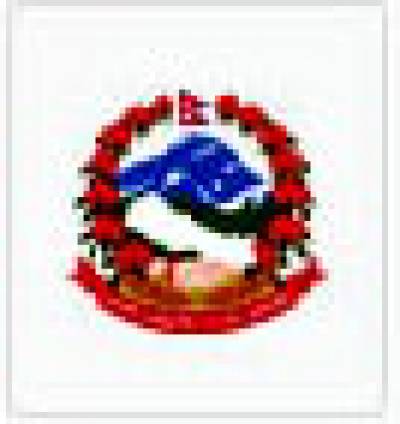ANNAPURNA CIRCUIT TREK 16 DAYS
This 16-day trek takes you through the Annapurna Conservation Area and to the highest alpine pass in the world – Thorong La Pass (5,416m/17,769ft) and to Tilicho Lake. You will also trek through the deepest gorge - Kaligandaki Gorge (5,571m). Thorong La Pass and the Kali Gandaki Gorge are just two of the astonishing features on this trek. You will discover why this is the most popular trekking region in Nepal. You will follow trails through beautiful rhododendron, oak, bamboo and cyprus forests and be taken aback at the closeness of the massive snow covered peaks: Annapurna I, II, III, IV, Dhaulagiri (8167m) (meaning white beautiful mountain in Sanskrit), Machapuchare (Fish Tail), Annapurna South and Manaslu. You will also experience the diverse cultures of the villagers living in this remote region with a visit to the celebrated Buddhist and Hindu holy site at Muktinath. It is claimed that there are more than a 100 varieties of orchids in the region, as well as many animals like the Martin deer, Langur monkey and the elusive Snow Leopard.
Trekking in the Annapurna region will expose you to the renowned Sherpas and their warm friendly smiles. They are also famous for their hardiness as high altitude mountain climbers. Their reputation is unparalleled in this field. Any serious expedition to the many huge peaks will very likely have Sherpas leading the way.
The actual trek starts from Syange and takes you through many villages: Dharapani (1,960m/6,430ft), Chame (2,710m/8,891ft), Pisang (3,300m/10824ft), Manang (3,500m/11,482ft), Yak Kharka (4,110m/13,484ft), Thorong Phedi (4420m/14501ft), Thorong La Pass (5416m/17764ft), Muktinath (3,800/12,467ft) from where you will drive to Jomsom (2,700m) and on finally on to Pokhara (8,50m). The final leg of this adventure sees us drive from Pokhara to Kathmandu (1,350m). On the trek we will set aside a day at Manang to better acclimatize and prepare before heading to Thorong La Pass, the highest altitude reached on the trek.
Sherpa Expedition & Trekking Team will assist with permits, meals and accommodation on the trek.
ITINERARY
Day 1 : Drive from Kathmandu to Dharapani (1960m) Duration: 8-9 hours.
An early start to the day sees us on a local bus heading to Syange. On the route you will get to see typical Nepali countryside and views of the mountains on the Annapurna circuit trek. You will pass raging rivers, lush vegetation and terraced fields of the farmers. Tonight we will stay at a guest house in Dharapani.
Day 2 : Trek from Dharapani to Chame (2650m) Duration: 5-6 hours.
The trail today is one that has been previously affected by landslides. We initially pass through a small village before starting on a gradual uphill trail to Bagarchhap, a typical Tibetan style village in the forest. We then follow the left bank of the river towards Koto, the gateway to the admired Nar Phu Valley Trekking route. We have a fairly easy trek from here to Chame, the administrative center of the Manang District.
Day 3 : Trek from Chame to Pisang (3250m) Duration: 5-6 hours.
After leaving Chame we come to Telekhu Village and on the trail have some excellent views of Annapurna and Pisang (6091m). We then re-cross the river on a suspension bridge to the south bank of the Marsyangdi River and climb up through a pine-forest as we follow the trail through the upper reaches of the Manang valley on our way to Pisang.
Day 4 : Trek from Pisang to Manang (3540m) Duration: 5-6 hours.
The town of Pisang is where we start our trek into the more isolated Upper Manang region. We first head to the Tibetan village of Braga with its distinctive architecture and houses that are constructed one upon the other. One of the main attractions here is its Gompa (Buddhist temple), the largest in the Manang region. Manang is also a favourite place with trekkers, as well as being the perfect place to acclimatize before heading to higher altitudes.
Day 5 : Acclimatization day at Manang.
Health experts strongly recommend that before heading to higher altitudes that trekkers spend some time acclimatizing. They also add that one should remain active during this acclimatization period. From Manang you will have some truly wonderful views of Annapurna II; Annapurna III (7555m); Gangapurna (7454 m); and in the south to Tilicho (7132 m); and the Grand Barrier (a 7000m ridge) in the west; Chulu West (6583m) and Chulu East (6059m) meters in the north. To assist with the acclimatization process we will climb up to Mt. Khangsar (3756m).
Day 6 : Trek from Manang to Tilicho Base Camp (4150m) Duration: 6-7 hours.
This morning we cross a rive and then trek through an alpine forest and will pass through several settlements, including Khangsar and Siri Kharka before arriving at the Tilicho Base Camp. The trail is strewn with rubble and the aftereffects of landslides, but at sunset we will be rewarded with some awesome sunset views over the mountains. We will stay in a guest house at Tilicho Base camp for the night.
Day 7 : Hike up to Tilicho Lake and trek to Shree Kharka (3900m) Duration: 6-7 hours.
At around 4:30 am we head to Tilicho Lake with its pristine turquoise water and then return to Tilicho Base Camp for lunch before heading off to Shree Kharka where we will stay the night.
Day 8 : Trek from Shree kharka to Yak Kharka (4050m) Duration: 5-6 hours.
This morning we begin our day by descending to Khangsar Village via Tare Gumba (3870m) - well-known for its Buddhist monastery. We then follow the trail through the Thorong Khola Valley until we arrive at the abandoned village of Old Khangsar before coming to Yak Kharka where we will stay overnight.
Day 9 : Trek from Yak Kharka to Thorong Phedi (4533m) Duration: 4-5 hours.
As we ascend we will slowly get used to the higher altitudes. We will take the trail along the east bank of the Jarang Khola (river) and be bordered by steep bluffs before coming to Thorong Phedi (meaning foot hills). We may decide to trek for another hour to High Camp (4800m). If we are lucky we may get to see the famous blue sheep and even the secretive snow leopard! This is also the habitat to the Lammergeyer (bearded vulture). There is also a belief the fabled griffons (creature with a lion’s body & bird’s head) inhabit this region.
Day 10 : Trek to Muktinath via Thorong La Pass (5416m) and drive to Jomsom (2743m) Duration: 8-9 hours
Today is most likely going to be the hardest day on the trail as we trek for around 8 to 9 hours. The higher altitude adds to the difficulty, and at times strong winds in these upper regions make it harder going. On the trail we will most likely pass sheep, yaks and merchants transporting various goods along the trails from Tibet. Once we arrive at Thorong La Pass we will have some amazing views of Annapurna, Gangapurna and the stunning peak of Khatungkang (6484m). We will then descend around 1600 metres with the trail gradually more undulating and relatively easy-going before we arrive at Jomsom.
Day 11 : Drive from Jomsom to Tatopani (1200m) Duration: 4-5 hours.
Today we will enjoy a mountainous scenic drive to Tatopani from Jomsom with some splendid mountain views on the route. We will pass through several small villages before arriving at Tatopani where we stay overnight. The therapeutic hot springs here are an ideal place to relax those tired limbs.
Day 12 : Trek from Tatopani to Ghorepani (2874m) Duration: 7-8 hours.
This morning we follow the trail, cross a suspension bridge over the Kaligandaki River and then continue until we come to a junction of two trails from where we ascend through terraced farms and villages. We then trek through a dense rhododendron forest before coming to the village of Chitre and eventually to Ghorepani where we will stay the night.
Day 13 : Hike up to Poon Hill (3210) and trek to Tadapani (2590m) Duration: 6-7 hours.
We will be up bright and early – before sunrise, in order to appreciate the sunrise views over the mountains. We will have some of the finest mountain views in Nepal from Poon Hill lookout. The rising sun will cast its light in various shades over the snow covered mountains and will be entrenched in your mind forever. We will then head back to Ghorepani for breakfast and then continue on to Tadapani where we will stay the night.
Day 14 : Trek from Tadapani to Ghandruk (1940m) Duration: 3-4 hours.
This morning we will wake up to views of Mt. Machhapuchare (Fishtail) and Annapurna South. The trail takes us through forested hills. The Gurung people are the dominant caste in Ghandruk. You will have an opportunity to explore the village and enjoy their warm hospitality. From Ghandruk we will have some fantastic views of the Annapurna Massif.
Day 15 : Trek from Ghandruk to Nayapul and drive to Pokhara (827m) Duration: 5-6 hours.
Today is the last day of trekking in the Annapurna region as we head down to Nayapul. From Nayapul we will go by car to Pokhara where we will stay in a 3 Star hotel for the night. Once settled in your hotel you can head out and explore the city or enjoy the sunset from one of the many cafes next to Phewa Tal (lake).
Day 16 : Drive from Pokhara to Kathmandu (1350m) Duration: 6-7 hours.
This morning we head back to Kathmandu by tourist bus. We will stop along the way for lunch and refreshments. On the route we will pass villages, raging rivers and see numerous terraced fields being attended to by farmers.
SERVICES
Cost Included In Your package
- Kathmandu - Beshisahar transfers on a local bus, Pokhara - Kathmandu transportation on a Tourist bus
- Beshisahar to Dharapani transportation by sharing a Jeep
- One night hotel accommodation in Pokhara with breakfast
- 3 Meals a Day [Breakfast, Lunch, and Dinner] during the trek
- Accommodation on beautiful cozy tea houses as per the itinerary
- Annapurna Conservation Area Project (ACAP) entry permits and Trekkers Information Management System (TIMS) cards
- Experienced English speaking, government licensed and ministry of tourism trained trekking guide with meals, accommodation, salary and insurance
- Strong experienced Sherpa helpers [porters] with meals, accommodation, salary, and insurance
- Assistant trekking guide for groups over 8 people with meals, accommodation, salary, and insurance
- Trip achievement certificate after successful trip completion.
- Use of sleeping bag, down jacket, duffel bag and walking poles (if you don’t have your own, to be returned after trip completed).
- Sherpa Expedition and Trekking T-shirt
- Oxygen meter to check your pulse and oxygen saturation and heart rate twice daily (Very useful to check Altitude Mountain Sickness(AMS) symptoms) which will ensure your health during the trek.
Costs Exclude
- Meals whilst you are in Kathmandu & Pokhara - lunch, and dinner.
- Nepal entry visa fee (easy to obtain the visa on arrival at Tribhuvan International Airport – Kathmandu). $30 USD for 15-day, $50 USD for 30 Days, and $125 USD for 90 Days visa.
- Personal travel and medical insurance.
- Hotel accommodation In Kathmandu
- International airfare.
- Your personal expenses.
- All the alcoholic and nonalcoholic, soup, tea, coffee, hot chocolate, cocoa, mineral water, extra food, cold and hot drinks on trek ( i.e. those you choose to purchase along the way and during evenings in the tea houses)
- All desserts & sweet things like chocolate, cake, pie, pudding.
- Hot shower and battery charging at the tea houses.
- Tips for the guide, porter, and driver (tipping is expected)
EQUIPMENTS
The following information will give you some idea about what you need to bring for the trek. It is important you do not forget the essential items, as this will determine your comfort and safety on the trek. Equally important is that you do not burden yourself with unnecessary equipment on the trek.
General
- All season sleeping bag and down Jacket (we can provide if you need it, but has to be returned after the trek)
- Duffle bag ( Sherpa Expedition & Trekking provide duffle bag during the trek but has to be returned after the trek)
- A wind and waterproof thin layered jacket (a must-have for morning and evenings above 3,000m)
- Daypack
Upper Body- Head / Ears / Eyewear
- A pair of half gloves
- A warmer hat that covers the ears
- Sunglasses
- Neckwarmer
- Sunscreen (35 to 60 SPF)
- Headlamp and an extra set of batteries
Hands
- A pair of half gloves for walking poles(if you prefer)
- Warmer shell gloves and liner
Upper Body
- long sleeve t-shirts
- Thermal tops
- wool jacket or pullover
- Sports bras for women and girls
- Water and windproof shell jacket
Lower Body
- Thermal underwear (especially trousers)
- windproof and waterproof trousers
- warmer trousers
- Comfortable trekking pants
- Extra casual sport pants
Footwear
- A pair of good waterproof trekking boots
- Pair of sandals
- 4-5 pairs of woolen socks
- Sock liners
- Light shoes and sneakers
- First Aid Kits and Medicines
- Assorted adhesive bandages (fabric preferred)
- Blister treatment cream or similar
- Insect / anti-itch ointment
- Ibuprofen or other pain-relief medication
- Diamox (125mg to 250mg tablets for altitude sickness)
- Warps, splints, and wound coverings butterfly bandage
- Water purifying pills
(Note our company guide will carry the medicines and first aid kits during the trek. However, we recommend you bring your personal first-aid kit as well)
Miscellaneous - but must useful on the trek
- 4 passport size photos with original passport
- Water bottle & filter
- Flight details (please make a copy and leave one pic at our office in KTM because in case you want to change your flight date)
- Bathroom kit (conform, should be included toilet paper, plastic bags, hand wipes, towel, and soap, etc.)
Extra things
- Comfortable trekking poles
- Quality energy dry foods (up to you)
- Power bank and music players
- Camera (memory card, chargers, and extra batteries)
GOOD TO KNOW
Accommodation
You will be accommodated in 3-star hotels in Kathmandu. During the trek, we will be staying at lodges/ teahouses. You may find comfort and better quality teahouses - having attached bathroom at lower levels- until you reach higher elevations, where the accommodation is more basic with bare necessities.
Meals during the trek
In Kathmandu, your hotel includes breakfast, whereas all meals (breakfast, lunch, and dinner) will be provided during the trek. A staple food of the Manang & Mustang regions is potatoes, oats, buckwheat, Sherpa stew, and Tibetan bread. Sherpa’s’ started farming potatoes when the first seeds were introduced to the region in the early 90s. There is a limited choice of food at higher elevations and except many potato dishes. Potatoes are high in carbohydrates – an excellent source of energy needed at high altitudes.
Transportation
We use a private car for sightseeing and for the airport to hotel pick and drop off. We use public transportation or local buses during the trek.
Physical fitness
This can be a challenging trek where you often have to walk 6-7 hours a day. You need past experience of hiking or trekking but if you have done any kind of trekking activities then it is always a plus! We have met people from all walks of life, shapes, and sizes who have completed the trek. The only difficult part is when altitude sickness strikes and the effect that it can have on your body. Before leaving for Nepal it is good if you can prepare yourself physically by increasing your stamina and oxygen intake.
Remember – The better prepared – the more enjoyable your trek!
MAP
PHOTOS/Videos
Departures
Select a departure month
Fill out the form below and a Travel Expert will reach out to create your perfect tour.
FAQS
What is the Annapurna Circuit Trek?
The Annapurna Circuit Trek is a popular trekking route in Nepal that takes you around the Annapurna massif, offering stunning views of the Himalayas, diverse landscapes, and rich cultural experiences. It is known for its challenging mountain passes and varied terrain.
How long is the Annapurna Circuit Trek?
The duration of the Annapurna Circuit Trek can vary depending on the specific itinerary and trekking agency. Typically, it takes around 8-20 days to complete the full circuit. This includes the trekking days and acclimatization/rest days.
What is the best time to do the Annapurna Circuit Trek?
The best time to do the Annapurna Circuit Trek is during the spring (March to May) and autumn (September to November) seasons. These months offer pleasant weather, clear skies, and favorable trekking conditions. However, the trek can be done throughout the year, with the exception of the monsoon season (June to August) when the trail can be muddy and prone to landslides.
Do I need a permit for the Annapurna Circuit Trek?
Yes, you will need a TIMS (Trekkers' Information Management System) card and an Annapurna Conservation Area Permit (ACAP) to do the Annapurna Circuit Trek. These permits can be obtained in Kathmandu or Pokhara.
What is the difficulty level of the Annapurna Circuit Trek?
The Annapurna Circuit Trek is considered to be a moderately to strenuously challenging trek. It involves long days of walking, crossing high mountain passes, and navigating varied terrain. A good level of fitness and prior trekking experience are recommended.
What is the maximum altitude reached during the Annapurna Circuit Trek?
The highest point on the Annapurna Circuit Trek is Thorong La Pass, which stands at an elevation of 5,416 meters (17,769 feet). This is a challenging and physically demanding part of the trek.
What are the accommodation and food options during the trek?
Accommodation during the Annapurna Circuit Trek is usually in basic teahouses or lodges along the trail. These provide simple rooms with shared facilities. As for food, you can expect to find a variety of Nepali and international dishes, including dal bhat (rice and lentil soup), momo (dumplings), and noodles.
Is a guide necessary for the Annapurna Circuit Trek?
While it is not mandatory to hire a guide for the Annapurna Circuit Trek, it is highly recommended, especially if you are not familiar with the area or have limited trekking experience. A guide can provide valuable insights, help with navigation, and ensure your safety throughout the trek.
What should I pack for the Annapurna Circuit Trek?
Some essential items to pack for the Annapurna Circuit Trek include sturdy trekking shoes, warm clothing, a good-quality backpack, a sleeping bag, a water bottle, a hat, sunscreen, insect repellent, and a first aid kit.
Can I combine the Annapurna Circuit Trek with other treks in the region?
Yes, it is possible to combine the Annapurna Circuit Trek with other treks in the Annapurna region, such as the Annapurna Base Camp Trek or the Tilicho Lake Trek. This allows you to customize your trekking experience and explore more of the stunning landscapes and cultural diversity of the area.
Latest Traveller’s Reviews
Travel experiences of our clients who recently returned from their trips.
100%
Based On 24 Reviews
Emerson Asher
Norway
October 18, 2024
Amazing Hospitality
Sherpa Expedition's hospitality on the Annapurna Circuit Trek was amazing. From the warm welcomes at tea houses to the delicious meals prepared by our team, every detail was taken care of. Our guide was passionate and knowledgeable, making sure we were comfortable and informed throughout the trek. The camaraderie built among our group was special, and the breathtaking scenery was a constant reminder of why I chose this trek. I would wholeheartedly recommend Sherpa Expedition
Latonya Cooper
Australia
October 6, 2024
Inspiring and Beautiful
Trekking the Annapurna Circuit with Sherpa Expedition was both inspiring and beautiful. The team's commitment to our safety and enjoyment was evident from the start. Our guide was not only skilled but also passionate about sharing the wonders of the Himalayas. The trek itself was a mixture of challenges and breathtaking beauty, from towering peaks to serene valleys. I came away from this experience with a deep appreciation for the mountains and the culture. I highly recommend Sherpa Expedition for an unforgettable adventure
Benny Collette
Canada
September 25, 2024
Perfect Blend of Adventure and Culture
Sherpa Expedition provided the perfect blend of adventure and cultural immersion during our Annapurna Circuit Trek. The team’s professionalism was evident as they guided us through some of the most stunning landscapes I’ve ever seen. I loved visiting local villages and learning about their way of life. The balance between trekking and cultural experiences made this trip truly special. I couldn’t have asked for a better guide or a more supportive team
People Considering This Package Right Now Check availability


























